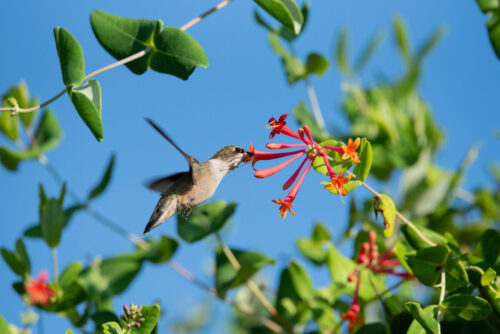Native Plants for Hummingbirds
July 21, 2022 8:36 am

By Ellen Powell, DOF Conservation Education Coordinator
You’re working in the garden when you notice a low-pitched hum, and you look around for its source. Could it be a territorial carpenter bee? A clumsy June beetle? Someone’s tiny, wayward drone? No, it’s a hummingbird – our favorite feathered pollinator!

Female ruby-throated hummingbird feeding on coral honeysuckle; photo by Cory Swift-Turner
The ruby-throated hummingbird is the only species that breeds in the East, although you might see an occasional rufous hummingbird during migration. Only the male has a red throat; the female’s is plain white. Both males and females are equally feisty in defending “their” flowers or feeders from other hummingbirds, insects, and even from larger birds they perceive as a threat.
You may have noticed that hummingbirds prefer some flowers over others. The relationship between plants and their pollinators is complex. Pollination, of course, is necessary for plant reproduction. Many plants have evolved adaptations to attract their most efficient pollinators. For example, flowers that rely on bees have different forms, colors, patterns, and scents than those that attract butterflies, beetles, or other pollinators. To increase their chances of getting this valuable service, the flowers provide pollinators with a valuable food resource, usually in the form of nectar or excess pollen. It’s one of nature’s great examples of mutualism – a relationship that benefits both parties.
Flowers that attract hummingbird pollinators tend to be red or pink and have long, tubular flowers. In most cases, the flowers have little to no scent, as birds have a pretty poor sense of smell. The hummingbird’s long, thin bill is specially adapted to probe for nectar hidden at the base of tubular or trumpet-like flowers.
Below are some native flowers that attract hummingbirds. Scientific names are provided to help you seek these out at your local nursery. (Common names can be misleading and might even get you the wrong species.)
Native azaleas, like pinxter flower (Rhododendron periclymenoides), feed the earliest hummingbird migrants on their way back from their wintering grounds. Fire pinks (Silene virginica) are another early-blooming energy source for hummers.
- A hummer’s belly feathers transfer pollen while it feeds on pinxter flower azalea.
- Fire pinks feed early spring migrants..
Cardinal flower (Lobelia cardinalis) grows well in moist areas and tolerates either sun or shade. Bee balm (Monarda didyma) is a member of the mint family that grows best on sunny sites.
- Cardinal flower
- Scarlet bee balm; photo by Mark Stone
The native coral honeysuckle vine (Lonicera sempervirens) won’t take over your garden (as opposed to the invasive Japanese honeysuckle.) In contrast, trumpet vine (Campsis radicans) can be an aggressive grower, so plant it where you have lots of space.
- Coral honeysuckle
- Trumpet vine
Pollinator gardening is one way you can make a positive environmental impact, even in the smallest yard. As you’re planning and planting for pollinators, don’t forget the feathered variety. Bring on the red flowers, and watch the fun!
Tags: Native Species, Wildlife, Woodland Plants
Category: Education





